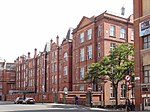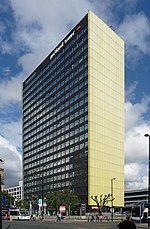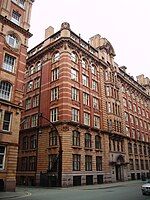Mechanics' Institute, Manchester
Grade II* listed buildings in ManchesterTrades Union CongressUniversity of Manchester

The Mechanics' Institute, 103 Princess Street, Manchester, is notable as the building in which three significant British institutions were founded: the Trades Union Congress (TUC), the Co-operative Insurance Society (CIS) and the University of Manchester Institute of Science and Technology (UMIST). In the 1960s it was occupied by the Manchester College of Commerce. It has been a Grade II* listed building since 11 May 1972.
Excerpt from the Wikipedia article Mechanics' Institute, Manchester (License: CC BY-SA 3.0, Authors, Images).Mechanics' Institute, Manchester
Princess Street, Manchester City Centre
Geographical coordinates (GPS) Address Nearby Places Show on map
Geographical coordinates (GPS)
| Latitude | Longitude |
|---|---|
| N 53.4769 ° | E -2.2392 ° |
Address
Princess Street 103
M1 6DD Manchester, City Centre
England, United Kingdom
Open on Google Maps









